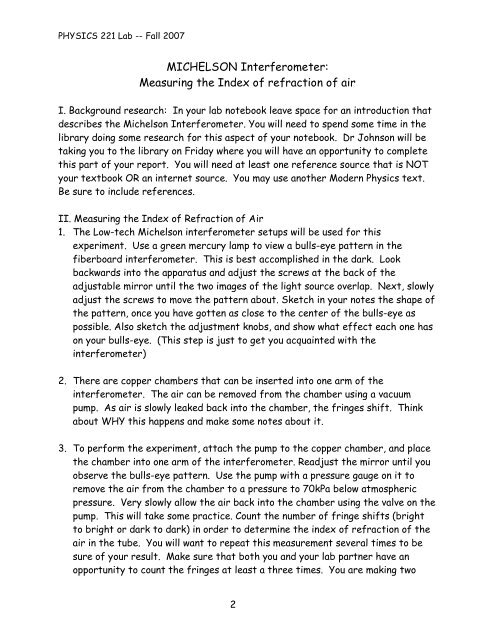MICHELSON Interferometer: Measuring the Index of refraction of air
MICHELSON Interferometer: Measuring the Index of refraction of air MICHELSON Interferometer: Measuring the Index of refraction of air
PHYSICS 221 Lab -- Fall 2007MICHELSON Interferometer:Measuring the Index of refraction of airI. Background research: In your lab notebook leave space for an introduction thatdescribes the Michelson Interferometer. You will need to spend some time in thelibrary doing some research for this aspect of your notebook. Dr Johnson will betaking you to the library on Friday where you will have an opportunity to completethis part of your report. You will need at least one reference source that is NOTyour textbook OR an internet source. You may use another Modern Physics text.Be sure to include references.II. Measuring the Index of Refraction of Air1. The Low-tech Michelson interferometer setups will be used for thisexperiment. Use a green mercury lamp to view a bulls-eye pattern in thefiberboard interferometer. This is best accomplished in the dark. Lookbackwards into the apparatus and adjust the screws at the back of theadjustable mirror until the two images of the light source overlap. Next, slowlyadjust the screws to move the pattern about. Sketch in your notes the shape ofthe pattern, once you have gotten as close to the center of the bulls-eye aspossible. Also sketch the adjustment knobs, and show what effect each one hason your bulls-eye. (This step is just to get you acquainted with theinterferometer)2. There are copper chambers that can be inserted into one arm of theinterferometer. The air can be removed from the chamber using a vacuumpump. As air is slowly leaked back into the chamber, the fringes shift. Thinkabout WHY this happens and make some notes about it.3. To perform the experiment, attach the pump to the copper chamber, and placethe chamber into one arm of the interferometer. Readjust the mirror until youobserve the bulls-eye pattern. Use the pump with a pressure gauge on it toremove the air from the chamber to a pressure to 70kPa below atmosphericpressure. Very slowly allow the air back into the chamber using the valve on thepump. This will take some practice. Count the number of fringe shifts (brightto bright or dark to dark) in order to determine the index of refraction of theair in the tube. You will want to repeat this measurement several times to besure of your result. Make sure that both you and your lab partner have anopportunity to count the fringes at least a three times. You are making two2
PHYSICS 221 Lab -- Fall 2007<strong>MICHELSON</strong> <strong>Interferometer</strong>:<strong>Measuring</strong> <strong>the</strong> <strong>Index</strong> <strong>of</strong> <strong>refraction</strong> <strong>of</strong> <strong>air</strong>I. Background research: In your lab notebook leave space for an introduction thatdescribes <strong>the</strong> Michelson <strong>Interferometer</strong>. You will need to spend some time in <strong>the</strong>library doing some research for this aspect <strong>of</strong> your notebook. Dr Johnson will betaking you to <strong>the</strong> library on Friday where you will have an opportunity to completethis part <strong>of</strong> your report. You will need at least one reference source that is NOTyour textbook OR an internet source. You may use ano<strong>the</strong>r Modern Physics text.Be sure to include references.II. <strong>Measuring</strong> <strong>the</strong> <strong>Index</strong> <strong>of</strong> Refraction <strong>of</strong> Air1. The Low-tech Michelson interferometer setups will be used for thisexperiment. Use a green mercury lamp to view a bulls-eye pattern in <strong>the</strong>fiberboard interferometer. This is best accomplished in <strong>the</strong> dark. Lookbackwards into <strong>the</strong> apparatus and adjust <strong>the</strong> screws at <strong>the</strong> back <strong>of</strong> <strong>the</strong>adjustable mirror until <strong>the</strong> two images <strong>of</strong> <strong>the</strong> light source overlap. Next, slowlyadjust <strong>the</strong> screws to move <strong>the</strong> pattern about. Sketch in your notes <strong>the</strong> shape <strong>of</strong><strong>the</strong> pattern, once you have gotten as close to <strong>the</strong> center <strong>of</strong> <strong>the</strong> bulls-eye aspossible. Also sketch <strong>the</strong> adjustment knobs, and show what effect each one hason your bulls-eye. (This step is just to get you acquainted with <strong>the</strong>interferometer)2. There are copper chambers that can be inserted into one arm <strong>of</strong> <strong>the</strong>interferometer. The <strong>air</strong> can be removed from <strong>the</strong> chamber using a vacuumpump. As <strong>air</strong> is slowly leaked back into <strong>the</strong> chamber, <strong>the</strong> fringes shift. Thinkabout WHY this happens and make some notes about it.3. To perform <strong>the</strong> experiment, attach <strong>the</strong> pump to <strong>the</strong> copper chamber, and place<strong>the</strong> chamber into one arm <strong>of</strong> <strong>the</strong> interferometer. Readjust <strong>the</strong> mirror until youobserve <strong>the</strong> bulls-eye pattern. Use <strong>the</strong> pump with a pressure gauge on it toremove <strong>the</strong> <strong>air</strong> from <strong>the</strong> chamber to a pressure to 70kPa below atmosphericpressure. Very slowly allow <strong>the</strong> <strong>air</strong> back into <strong>the</strong> chamber using <strong>the</strong> valve on <strong>the</strong>pump. This will take some practice. Count <strong>the</strong> number <strong>of</strong> fringe shifts (brightto bright or dark to dark) in order to determine <strong>the</strong> index <strong>of</strong> <strong>refraction</strong> <strong>of</strong> <strong>the</strong><strong>air</strong> in <strong>the</strong> tube. You will want to repeat this measurement several times to besure <strong>of</strong> your result. Make sure that both you and your lab partner have anopportunity to count <strong>the</strong> fringes at least a three times. You are making two2
measurements in each trial, <strong>the</strong> <strong>air</strong> pressure and <strong>the</strong> number <strong>of</strong> fringes. Besure to make an estimate <strong>of</strong> your uncertainty in each type <strong>of</strong> quantity andrecord it and your reasoning in your lab notebook.4. You can now calculate <strong>the</strong> change in <strong>the</strong> index <strong>of</strong> <strong>refraction</strong> using <strong>the</strong> principlesbehind <strong>the</strong> Michelson interferometer. You will first need to determine anequation that relates <strong>the</strong> index to <strong>the</strong> fringes. Next you will need to determinehow <strong>the</strong> change in index is related to <strong>the</strong> number <strong>of</strong> fringes.5. You should compare your result with an accepted value <strong>of</strong> <strong>the</strong> change in <strong>the</strong>index <strong>of</strong> <strong>refraction</strong> <strong>of</strong> <strong>air</strong> by using a reference source to find <strong>the</strong> acceptedvalue <strong>of</strong> <strong>the</strong> index <strong>of</strong> <strong>refraction</strong> at atmospheric pressure and at 70kPa belownormal atmospheric pressure. The National Institute <strong>of</strong> Standards andTechnology has a calculator <strong>of</strong> <strong>the</strong> index <strong>of</strong> <strong>refraction</strong> <strong>of</strong> <strong>air</strong> that can be foundat http://emtoolbox.nist.gov/Wavelength/Ciddor.asp



